The history of Almussafes
It must have sounded strange to someone that this is the second Ford plant in Spain. Back in 1907, Ford already had a dealership in Cadiz, where it sold the Ford T in a wide range of colours... as long as it was black. As sales were going from strength to strength, in 1919 Henry Ford I decided it was time to open a factory on Spanish soil. A year later, in 1920, the first Ford T made in Spain rolled off the Cadiz line. At that time, setting up a factory was not excessively complex, as it did not require as much robotics as it does today.
For this reason, three years later the production was moved to Barcelona, remaining active until 1930, when it would close definitively. In 1936, Ford intended to build a new factory, but gave up after the beginning of the Civil War. After this dark period of our history, the Second World War followed, so Ford was not going through its best times and decided to end its presence in our country in 1944.
After this first incursion of Ford in Spain, the successor, Henry Ford II, was determined to have again a factory in our country, for the production of its new Fiesta model. In 1970 the first contacts with the government of that time began, for the implementation of a factory in Valencia, as there were the blast furnaces of Sagunto, so that access to steel coils for the manufacture of bodywork was very convenient. Due to the high protectionism exercised by the government with SEAT, Henry Ford II took 3 years to get the necessary tax advantages, so that the implementation of the factory in Spain would be beneficial for the company.
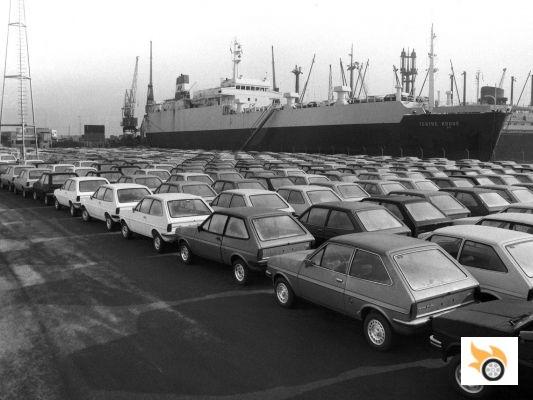
It was then, in April 1973 when it was officially announced the installation of the plant in Almussafes. From then on, everything accelerated: the land was bought in December of that same year, and in January 1974, work began on it. In March, Henry would return to Spain to lay the first stone, and 1000 days later, the factory was finished. After the final adjustments, in March 1976, the first engine was manufactured at the Almussafes factory, and 7 months later, on October 18, 1976, the first Ford Fiesta manufactured in Spain rolled off the assembly line.
Finally, on October 25, 1976, the Almussafes factory was officially inaugurated, with Henry Ford II acting as a luxury guide during the visit of the King and Queen of Spain. From that moment on, 1,000 cars and 1,400 engines per day were produced at the Ford plant in Valencia.
Here you have a video of the time in which you can see the process of stamping the body of the Fiesta in Almussafes:
Parts of the factory
As you can see in the image, the factory has five main parts, distributed in a linear way, occupying about 2.7 million square meters, with about 6,000 people in its facilities. The parts are:
- Spare parts, where the spare parts for the operation of the chain are stored.
- Engines, where the parts are received and the engines are assembled.
- Bodywork, where the steel is cut, stamped and then welded to form the bodywork.
- Painting, where the bodywork is subjected to the cataphoresis and painting process.
- Assembly, where all the elements are joined together to form a car.
There are also accessory facilities such as a test track, water treatment plants, waste collection, sports facilities and a classroom for the university school. All this results in a production rate of one car every 32 seconds, or 900 cars per eight-hour shift.
At the top of the image is the Juan Carlos I Industrial Park, which is very important for the factory, as it houses the auxiliary companies that supply components to Ford. Before talking about the suppliers, of vital importance for any car brand, let's take a look at how a car is produced. In this way, we will better understand the reason for this division in the Ford factory.
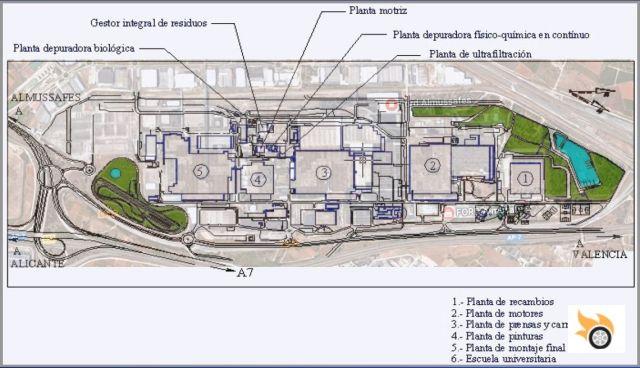
The production process of a car
For those of you who don't know in depth how a car is produced -we are sure a minority of pistonheads- we are going to make a brief review. To do this, we have to go back to the 70s, when Toyota had to adjust production costs to be competitive. Until then, the way to produce vehicles was based on what Henry Ford devised (Fordism): accumulate stock of parts and go making cars, they would be sold later.
From an economic point of view, this is inefficient, because you have money invested in parts that do not produce any profitability until they are sold. That's why Taiichi Ohno came up with what's called "Just In Time", whose philosophy is based on "producing the parts you need, in the quantities you need, when you need them". With this in mind, several guidelines are triggered:
- Flexible production
- Small batch production
- Minimisation of delivery and production times to a minimum
- Minimum stock of parts
- Zero errors
- Minimize technical plant stoppages
- Close relationship with suppliers
- Continuous improvement
- Use of kanban for logistics and quality control
- Work environment based on the 5S: Seiri (Sort), Seiton (Order), Seiso (Cleanliness), Seiketsu (Standardize) and Shitsuke (Discipline).
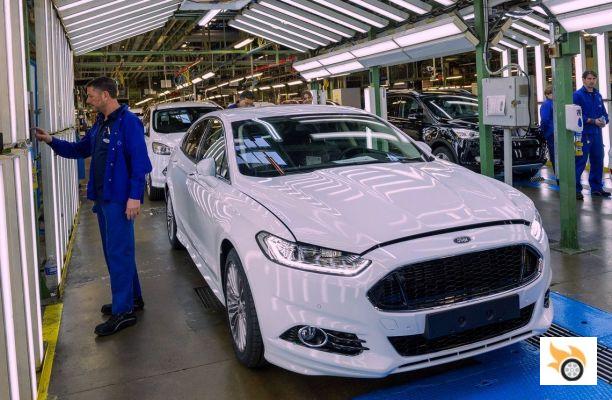
By putting the model to work, Toyota managed not only to reduce costs, but also to increase quality. So much so, that the rest of the car manufacturers followed in their footsteps and implemented it in all their production plants. Obviously the system has evolved over time and takes advantage of technological advances, especially in computer systems and communications, but still remains in force.
With this in mind, when someone enters a dealership and decides to buy a car, a myriad of orders are automatically unleashed, to request all the necessary parts from suppliers for the manufacture of that particular vehicle with our favorite color and options chosen - remember that to manufacture a car we will need about 75,000 parts - taking into account when they should arrive at the factory, to occupy the warehouse as little time as possible.
Now, what does a car manufacturer actually produce? Basically the body and the engines. Some brands also manufacture the sub-chassis and suspension arms, although in other cases this part is also outsourced. The rest - dashboard, interior panels, carpet, seats, wiring, electronics, lights, wheels, etc. - comes from external suppliers and the manufacturer's job is design and integration.
We are now going to look at the production processes in more detail, which although they are the same in general, each company makes variations to suit their philosophy. We will focus on those carried out at the Ford plant in Valencia.
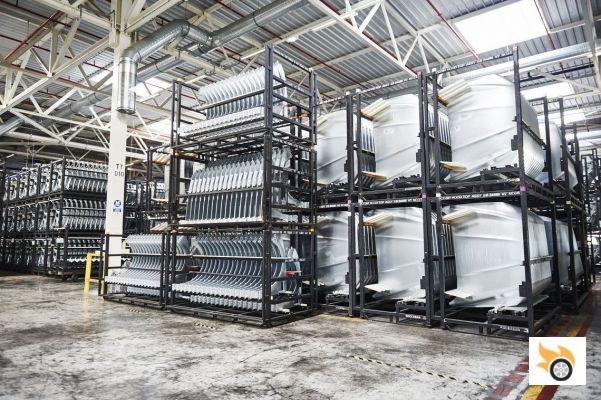
Pressing plant
This process is based on manipulating the steel coils to obtain the car's panels: sides, roof, floor and doors. Since weight reduction is imposed, this process has to change in the not too distant future, with the arrival of materials such as aluminum or carbon fiber and CFRP (Carbon Fiber Reinforced Plastic); but let's go back to the process. First of all, the 20 ton coils are unrolled and flattened by rollers, as the steel takes that shape after spending time bending. Shortly after, it is slid to be cut by hydraulic presses, to the right size depending on the type of panel to be stamped later. The cutting rate is about 20 pieces per minute for the roof or 40 pieces per minute for the doors.
Once the "platens" are cut, they go to the stamping phase. At this point, the piece slides into a press, which will have a specific mould for the part to be made. The force exerted by these monsters is about 1,000 tm, which is necessary to bend the steel at room temperature.
Afterwards, the excess steel is cut -which is recycled- and the part, after quality control, is ready for the next phase. Normally, not all the parts are checked, but periodic and random controls are carried out -one part every hour in the case of Almussafes- to control that the process is within the normal parameters.
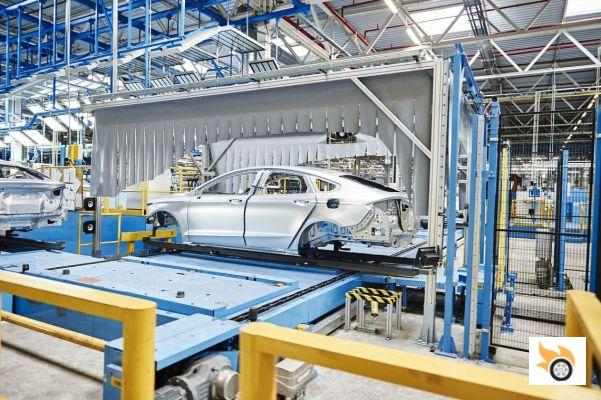
Bodywork plant
This is where the welding of the sides with the roof, floor and reinforcements is carried out to form the bodywork. There is hardly any human intervention in this step, as the task falls to the dozens of KUKA robots, one of the world's largest manufacturers of industrial robots. This entire process with some 3,000 welding points is completed in just 58 seconds at each station with extreme precision, moving on to the quality control process, where more robots will take measurements to check that the bodywork is within acceptable parameters according to the specifications.
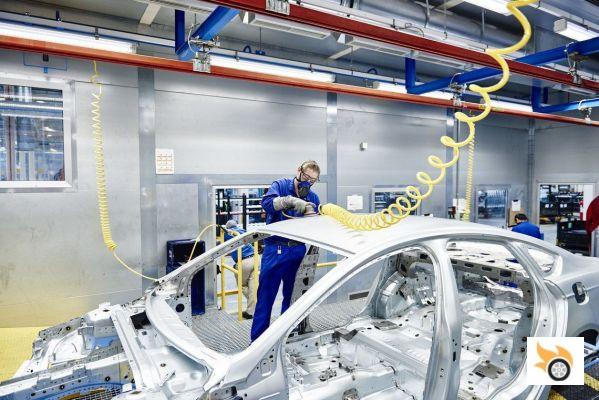
Paint Plant
This process is another of the most automated in any factory. The completed car bodies are received from the previous stage, and placed in suspension on a rail. During this journey, the body begins with a wash, to remove any dirt from its surface. Then, it goes to the electroplating paint bath: the liquid contains the paint particles in aqueous suspension, together with positive electrodes that supply between 100 and 400 V. The bodywork, being attached to the negative electrode, will attract the paint particles in suspension, and these will be stuck by the chemical reaction produced by the electric current flowing in the bath.
This ensures that the steel is not exposed to the elements, and therefore corrosion is avoided.
After cataphoresis and drying of the bodywork, it goes to the painting line, where more robots will apply powder paint to the exterior and interior, depending on the color selected by the customer. It is worth mentioning that these robots are very versatile, being able to change paint color in a few seconds, after the purging process. Coat of lacquer with UV protector, and that's it. From here, we go to the oven, where the paint is cured at 150 ºC for 15 minutes.
Finally, as in every process, the quality control is done. In the case of Almussafes, it is carried out by Made in Spain technology, thanks to the patent of the Polytechnic University of Valencia, with Josep Tornero at the head, who has sold it to Ford. By means of artificial vision, defects in the bodywork are detected, with a process that only takes 10 seconds and obtains an accuracy of 0.2 millimetres. The cost of this technology is about 800,000 euros, and Ford is implementing it in all factories worldwide. Thanks to this process, time is saved and defects are reduced, obtaining a shiny body.
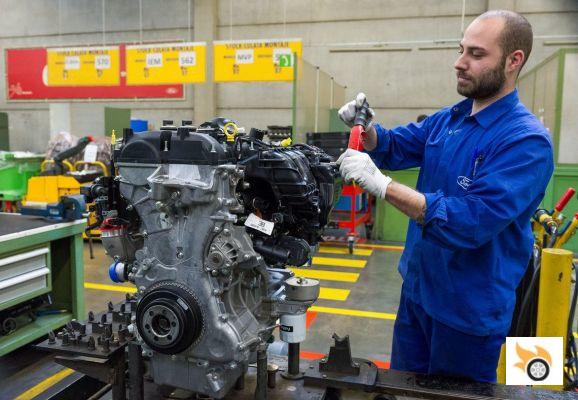
Engine plant
In this part of the factory, the engines are assembled from their individual parts. Some manufacturers incorporate in this part the casting of the block itself, although in Almussafes this does not happen. In the case of EcoBoost engines, they are imported from other Ford plants on the continent. Once it has been assembled and passed quality control, it will go to the assembly plant as just another component.
Assembly plant
And finally we come to the final stage where the car takes its final shape. Here the complete body arrives, so to facilitate the interior assembly operations, the first thing to be done is to dismantle the doors. They follow a parallel path in the chain, where the interior panels are assembled, to then meet almost at the end with the complete vehicle.
This is the area where most operators work, as flexibility is necessary, and today's robots are stationary. We can distinguish two areas: the first one where all the chassis components are assembled: suspensions, brakes and engine. And the second one, where the interior is assembled: dashboard, carpets, seats, etc. Prior to the assembly of the interior, both parts converge on the assembly line to perform the "marriage", that is, the chassis located below is screwed by operators to the body, which is located at the top.
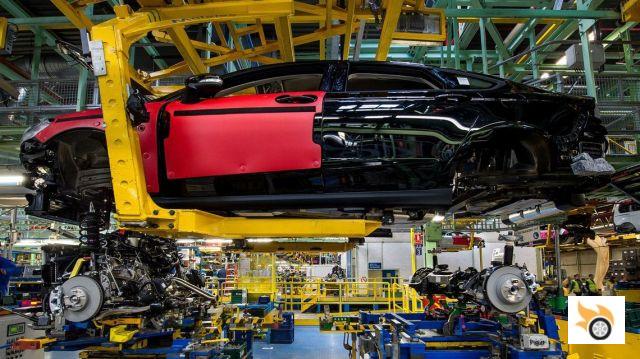
Lowering the body is a high-precision job, because the bolts on the chassis have to match the holes in the body. The first team joins both parts, performs a light tightening, and in the next station the final tightening is performed with the necessary precision to reach the required torque according to the design. Once both parts are joined, the assembly of the interior and the wheels begins, being the doors practically the last thing to be assembled.
Once we have turned a bunch of parts into a car, it's time to fill all the fluids: oil, coolant and a few liters of fuel. At this point, we can say that the car is finished. The only thing missing are the running-in and waterproofing tests. In the first one, the car is put on rollers at the end of the assembly line, and a programmed pattern is made to check that the engine and brakes work properly.
Every few units, a car is taken at random and tested more thoroughly on the track adjacent to the factory, mostly to check that there are no defects in suspension or steering. Of course, no more than 50 miles can be done, or else the car can't be sold as new. Finally, the waterproof test, which makes each car pass through a tunnel that simulates a tropical storm, to check that no water seeps into the interior. If it has passed these final tests, from this moment on the car is ready to leave the factory and head for its new home, where its new owner awaits impatiently.
If you want to see how is the manufacturing process in Almussafes, I leave a video to satisfy your curiosity:
The auxiliary industry
We cannot forget that in the Just In Time methodology we need to have the suppliers close, very close. In the case of Ford in Almussafes, an industrial park was built, just behind the factory, a few meters from it. In the Juan Carlos I Industrial Park are located more than 80 companies forming the APPI (Association of Owners and Users of the Industrial Park). Among them we can highlight multinationals such as Faurecia, Johnson&Control, Magna or Gestamp.
These large suppliers have direct access tunnels to the factory, and elevated trains to send their finished products when they are needed: that is, when the vehicle is practically on the assembly line. Let's remember that working with JIT requires exquisite coordination with suppliers, so that parts arrive on time and there are no delays that force the production line to stop.
This is the nightmare of any factory manager, because of the high impact on delays and cost involved. Remember what happened this past summer to Volkswagen for having certain "differences of opinion" with their suppliers: they had to stop the production of the Golf in Wolfsburg due to a conflict with the cancellation of certain orders to a couple of companies that supplied the upholstery of the seats and gearboxes. As we can see, in the automotive industry, suppliers are a key element for the factory to operate at full capacity.
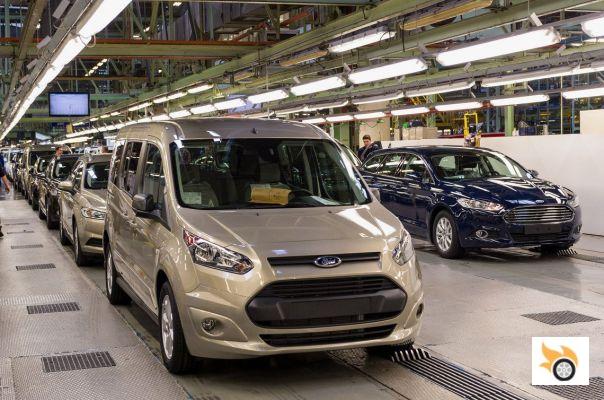
The economic impact
Like any large industry, building a car factory in a city has a huge economic impact. We are going to make a brief analysis from two points of view: the impact for the company that is implanted, and the impact for the population itself.
From the point of view of the company, the situation of a new factory involves many previous studies. Let's calculate, as an example, how many cars a plant like the one in Almussafes should manufacture and sell to be profitable. To do this, the first thing we need to know is what is the net profit per car. In the case of Ford, we are going to do it by calculating the percentage of net profit of its balance sheet. Here I leave you the figures -in millions of dollars- of Ford Motor Company, so you can get an idea of the shovelfuls of bills that car companies handle:
| Accounting as of December 31, 2015 | Millions of dollars |
|---|---|
| Total revenue | 149.558 |
| Total expenses | -126.495 |
| Gross profit | 23.063 |
| Selling, general and administrative expenses | -14.999 |
| Non-recurring | -417 |
| Operating profit | 7.647 |
| Other expenses | -274 |
| Net profit | 7.373 |
From this balance sheet we can conclude that the net profit is approximately 5% of income, which translated to an average car of 30,000 euros, would be a profit per car of approximately 1,500 euros. With this figure we are going to calculate how many cars we would need to produce to be profitable in a plant like the one in Almussafes.
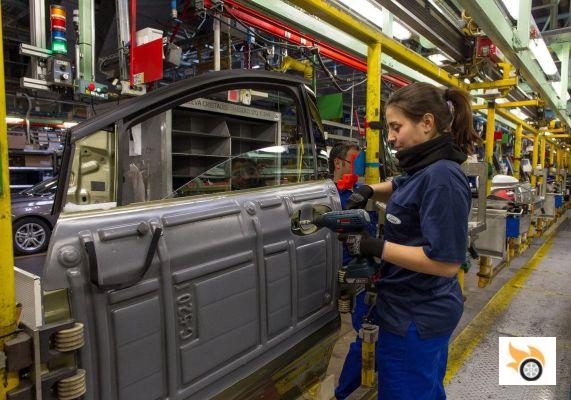
To do this we will assume that the plant has a cost of 4,000 million euros, and that we want to amortize in 5 years, the average life of the model we want to manufacture. Let's remember that each model has different moulds, and that these moulds for the presses are quite expensive. Not to mention the adjustments in the design and programming of the robots, which can also be quite considerable. Assuming that the average salary in Spain is 26,000 euros per year, with the 6,000 people working in Almussafes, we have an annual cost of 156 million euros in salaries.
To this we have to add taxes, which we are going to assume to be 44 million euros. This makes a total of 1,000 million euros of expenditure per year. If we divide this figure by the 1,500 euros of profit per car, the result is that we will have to manufacture and sell about 667,000 vehicles per year for five years to recover the investment. If the company also wants to make a profit, it would have to sell more than that. If any economist is reading this, don't worry: it's just a rough approximation to get a small idea of the big numbers that car companies have to deal with when it comes to setting up a factory.
Now let's look at the impact on the population. It is clear that the new factory is going to be a source of employment, not only in the factory itself, but also in the companies that supply components. Due to the Just In Time manufacturing philosophy that we explained earlier, it is essential that they are located very close to the factory, so, again, the impact on employment will be significant. To commemorate the 40th anniversary of Almussafes, Ford commissioned a study to the European University of Valencia, to quantify this economic impact. As you will understand, it is quite complicated to carry out, and we assume that a multitude of assumptions must be met for the figures to be fulfilled. In any case, this study estimates that each euro of added value generated at Ford generates 2.86 euros in the Valencian economy and how each job generated at Ford generates 5.8 jobs in the Valencian Community.
At a national level, each euro of added value generated at Ford generates 6.52 euros in Spain and each job generated at the company contributes to the creation of 11.7 jobs in Spain. The automotive sector in Valencia, with Ford as a benchmark, accounts for 80 percent of exports by rail and 40 percent of those made by sea. As you can see the situation of a factory is an engine for the economy and employment in the region, so necessary in these times.
Timeline
To finish, I leave you the main milestones and ephemeris of this factory during its 40 years of history.
1973
13/12 Purchase of the land in Almussafes
1974
19/1 The levelling of 108 plots of land starts
26/3 Laying of the "first stone" by Henry Ford II
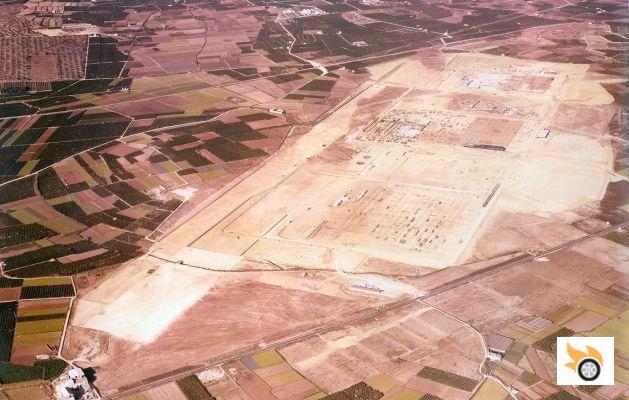
1976
01/3 Production of the first engine
18/10 Production of the first car, a Ford Fiesta
10/25 King Juan Carlos inaugurates the factory
1979
04/7 Production of the 1 millionth engine
1981
02/1 Production of the 1 millionth Fiesta
24/8 The Escort model goes into production
1982
25/2 2 millionth engine produced
1983
05/12 Orion model goes into production
1984
12/6 3 millionth engine produced
1985
05/12 Production of the 1,300 cc engine begins
1986
31/3 Fiesta 2 million produced
04/11 Visit of Their Majesties the King and Queen of Spain (10th Anniversary) The King and Queen of Spain (10th Anniversary)
1987
27/1 4 millionth engine produced
1989
02/1 Production of foamizado(quilted fabric) begins
04/1 Fiesta'89 (BE-13) goes into production
5/18 5 millionth engine produced
1990
20/3 Inauguration of the Training Center
27/8 Production of Escort'90 (CE-14 - 5 doors) begins
03/9 Orion'90 (CE-14 - 4 doors) goes into production
1991
11/3 Production of the 6 millionth engine
23/4 Awarding of the Q1 Quality Award to the Engine Plant (P.T.O.) granted by Ford Europe
15/5 1 million vehicles exported from the port of Valencia
14/10 Fiesta 3 million manufactured
18/10 4 millionth vehicle manufactured
12/11 Escort / Orion 1 million manufactured
1992
14/12 Awarding of the Q1 Quality Award to the Vehicle Manufacturing Plants (B.A.O.), given by Ford Europe
1993
15/1 Production of the 7 millionth engine
25/5 Presentation of the Q1 Quality Award for the Spare Parts Plant (P.S.O.), awarded by Ford Europe
29/9 Inauguration of the extension to the Training Centre
16/12 Henry Ford Technology Award received
1994
25/10 Received the European Award for Safety at Work for B.A.O. for 1993
1995
30/1 Presentation of the Industrial Park to suppliers
24/2 Inauguration of the University School
03/3 Manufacture of the 8 millionth engine
06/3 Announcement to the Press of the manufacture of the Ka (BE-146) at Valencia
27/3 Inauguration of the Pilot Plant
02/5 The 5 millionth vehicle is manufactured
05/5 Inauguration of ZETEC-SE Engine Plant
10/7 Presentation of the ZETEC-SE engine to the specialized European Press
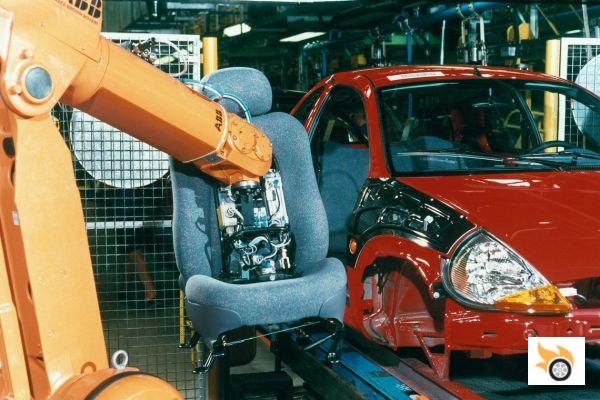
1996
14/6 Received the European Award for Safety at Work for P.T.O. in 1994
02/8 Fiesta 4 million manufactured
24/8 Inauguration of the Test Track
02/9 Ka (BE-146) goes into production
25/9 Presentation of the Ka to the Spanish specialized press
17/10 Visit of Their Majesties the King and Queen of Spain (20th Anniversary) The King and Queen of Spain (20th Anniversary)
17/10 Inauguration of the "Rey Juan Carlos I" Suppliers' Industrial Park
1997
30/7 The 9 millionth engine is manufactured
1998
20/7 ISO 14.000 certification obtained
31/7 Production of the Escort 1.5 million (End of Escort production)
31/8 Focus (CW-170) goes into production
11/13 Production of the 6 millionth vehicle
25/11 Presentation of the Focus to the Spanish trade press
1999
05/5 Obtained QS 9000 certification
16/9 The Engine Plant receives Quality Connection Certification
07/10 Lloyds Bureau Register awards the Almussafes Factory with the "Green Flag" which endorses the achievement of the ISO 14001 international standard certification.
12/11 Official announcement of the production of the I4 engine in Almussafes
2000
24/7 The 10 millionth engine is manufactured
29/11 The European Environmental Conference is held at the factory.
2001
05/3 Official announcement of the production of the new Fiesta model and the new Mazda B-platform model in Almussafes
August Obtained ISO 14.000 recertification - Lloyd's Register (2nd audit)
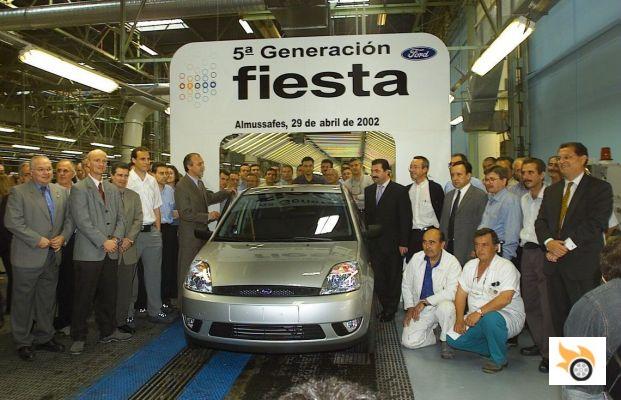
2002
4/29 1st 5th Generation Fiesta manufactured
17/6 The 1 millionth Ka is manufactured
01/10 First Duratec-HE engine is released
06/10 Start of third manufacturing shift in Vehicle Operations
2003
20/1 Mazda2 begins production
04/9 Received European Workplace Safety Award for V.O. + P.T.O. for the year 2002
25/9 Science Museum: Inauguration of exhibition "Ford: One Hundred Years of Automobiles".
2004
08/4 The 1 millionth Focus is manufactured
01/6 Manufacture of the 8 millionth vehicle
10/21 Obtained ISO 14.000 recertification - Lloyd's Register (3rd audit)
2005
10/1 1st Focus (C-307), 5-door, 2nd Generation, manufactured
07/2 1st Focus (C-307), 4-door, 2nd Gen, manufactured
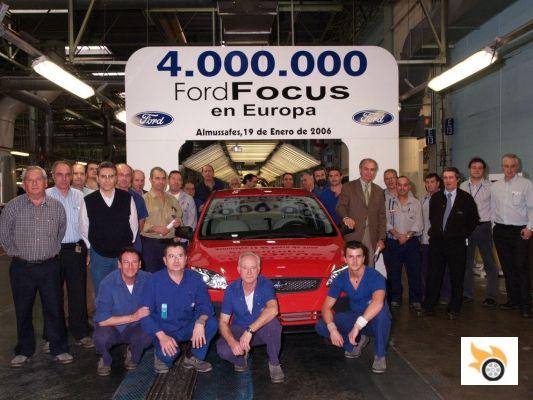
2006
19/1 4 millionth European Focus produced
17/10 30th Anniversary of Ford Spain and 10th Anniversary of the "Rey Juan Carlos I" Suppliers' Industrial Park
10/11 Manufacture of the 9 millionth vehicle
2007
30/5 Visit of the Minister of Industry, Joan Clos
22/6 The last Mazda2 is manufactured
28/6 Launch of the new Duratec-HE 2.3i 161hp engine
12/12 Delivery of the Integrated Environmental Certification to Ford España
2008
02/1 1st 3rd Generation Focus (CB 4) produced
04/2 Visit of the 1st Vice-President of the Government, Mª Teresa Fernández de la Vega
03/7 Manufacture of the 1 millionth Duratec-HE engine
25/7 The last Ka is manufactured
26/9 The last 5th Generation Fiesta manufactured
2009
21/1 1st Fiesta 6th Generation manufactured
10/28 10 millionth vehicle produced
2010
23/8 New Ford C-MAX Compact goes into production
17/9 New Ford Grand C-MAX goes into production
2011
29/7 End of Focus production
21/10 Visit to the factory by Alfredo Pérez Rubalcaba, 1st Vice-President of the Spanish Government
22/11 The 5 millionth Fiesta produced in Almussafes since its debut in 1976
2012
11/7 Production of the Duratec-HE 2 millionth engine
03/12 Production of the new Ford Kuga begins
2013
30/9 Transit and Tourneo Connect go into production
2014
18/2 11 millionth vehicle produced
04/7 Grand C-MAX production ends
01/8 C-MAX production ends
08/9 Mondeo goes into production
2015
05/2 Visit to the factory by Mark Fields (CEO of Ford) and Mariano Rajoy, President of the Spanish Government
20/5 Ford S-MAX, Ford Galaxy and Ford Mondeo Vignale go into production
2016
24/6 Ford S-MAX Vignale goes into production
25/10 40th Anniversary of the Almussafes factory
If any pistonudo has nothing planned for the weekend, here's a suggestion: to commemorate this anniversary, the City of Arts and Sciences will host an exhibition that reviews the 40 years of Ford Spain through photographs that reflect the trajectory of the company over the past four decades and a selection of models of the Ford Fiesta. The exhibition can be visited until 2nd November.

























